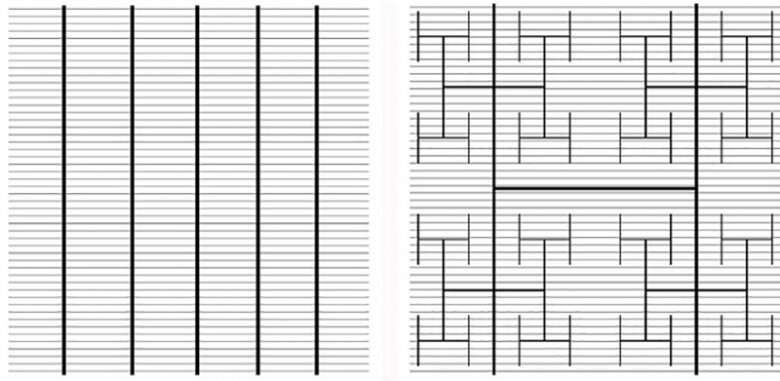Credit: University of Oregon
Stress reduction and improved solar electricity could someday come together in an unexpected package, and a University of Oregon study suggests that a new design of eye-pleasing, fractal-patterned rooftop solar panels could deliver the goods.
In an open-access study published in the journal PLOS ONE, an eight-member team led by UO physicist Richard Taylor and UO psychologist Margaret Sereno combined the psychology of aesthetics—in this case, the appreciation of beauty seen in nature—and the electrical engineering of solar panel designs.
"Our findings have the potential to address two major challenges of today's society simultaneously: the critical need for increased clean energy production and the need to reduce escalating stress-induced illnesses," Taylor said. "Stress currently costs the U.S. economy more than $300 billion annually."
In a series of studies involving 370 participants, the research team explored different fractal designs to determine which pattern was the most visually appealing. The winning patterns were based on an H tree structure in which fractal-shaped electrodes branch off like fingers in a repeating geometrical pattern resembling the letter H.
Electrodes in solar panels are incorporated into strips called busbars in a way that enhances conductivity for electrical production. The traditional approach has relied on Euclidean design, using a nonrepeating busbar rather than a repeating, across-scale fractal design for electrode placements. While successfully turning sunlight to energy, traditional designs have had little visual appeal.
Taylor has drawn on nature's fractal geometry for diverse applications, ranging from art authentication to a patented approach to create retinal implants to restore human vision. His collaboration with Sereno now suggests that fractal electrodes in solar panel photodiodes will surpass busbars aesthetically.
The studies drew from biophilia, defined in a hypothesis introduced in 1984 by Harvard University naturalist Edward O. Wilson as "the urge to affiliate with other forms of life." The current work is the latest in a series of publications by Sereno and Taylor investigating fractal fluency.
The researchers cited 13 studies that have found positive responses related to physiological stress reduction by people viewing both fractal patterns in nature and in computer-generated imitations. Fractal patterns observable in rooftop solar panels by people walking along a nearby path, they suggest, could help reduce stress, which the World Health Organization has recognized as a major global problem.
"Fractal fluency proposes that because of our exposure to nature's fractals through evolution, our visual system has become tuned to more easily process these common fractal patterns," said Sereno, an associate professor in the UO's Department of Psychology. "This ease in processing generates an aesthetic effect accompanied by stress reduction."
The H tree design is easily produced and fits within the general design of standard busbars now used for installing solar cells in rooftop construction, the researchers noted. However, the reshaping of the thin aluminum electrodes in an H tree-based busbar was found to reduce panels' electrical efficiency.
To address this challenge, the team turned to electrical simulations to test the performance of possible designs. That, in turn, led to an analysis of potential power loss and efficiency of each design.
For optimum performance, the research team integrated the fractal and busbar designs. The novel hybrid electrode, Taylor said, captured the superior aesthetics of the fractal design and the superior electrical performance of the busbar design.
The research is not the first to explore the potential of fractal design of electrodes in solar panels, but it is the first to invent a design that marries performance with aesthetics. Taylor and Sereno are investigating other ways to incorporate stress-reducing fractal designs into the built environment.
Projects include a collaboration with the Mohawk Group to create fractal carpets, which will be installed this summer into the Phil and Penny Knight Campus for Accelerating Scientific Impact, and with Ihab Elzeyadi, a professor in the UO School of Architecture and Environment, to create light patterns cast by fractal window shades.
More information: Ellis T. Roe et al. Fractal solar panels: Optimizing aesthetic and electrical performances, PLOS ONE (2020). DOI: 10.1371/journal.pone.0229945
Journal information: PLoS ONE
Provided by University of Oregon
























